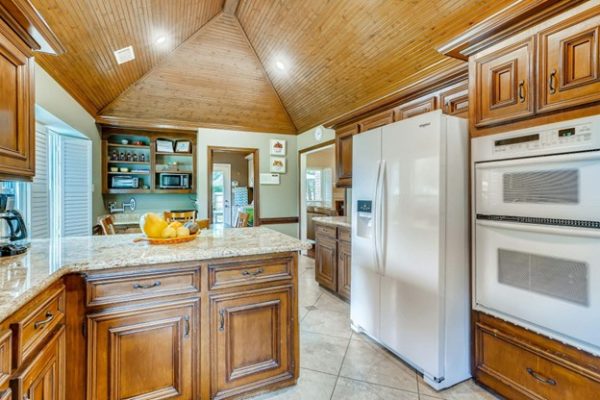
In small homes and apartments, the kitchen often becomes the trickiest area to design.
Limited square footage means every inch must serve a purpose, and the goal is to create a space that is not only functional but also inviting.
Space-saving kitchen designs focus on maximizing efficiency while maintaining style, and with thoughtful planning, even the smallest kitchens can be transformed into highly functional and aesthetically pleasing spaces.
If you’re dealing with a compact home, it’s important to adopt design strategies that work well for small spaces.
Just as efficient design principles are essential for kitchens, they’re equally valuable for other parts of the home.
For instance, considering https://elpasoscontractor.com/services/bathroom-remodeling/ that utilizes space-saving techniques can help ensure every corner of your home is optimized for both style and functionality.
The Importance of Space-Saving Kitchen Designs
Compact kitchens are becoming increasingly relevant as urban living spaces shrink and the trend towards minimalism grows.
These designs cater to diverse lifestyles by offering innovative solutions for limited spaces.
The emphasis is on creating a balance between practicality and personal style, often requiring creative approaches to layout, storage, and functionality.
Maximizing Efficiency: Space-saving kitchens ensure that everything is within reach and easy to use.
This is particularly important in small homes and apartments, where a lack of space can make traditional kitchen setups inefficient and cluttered. Work with a reliable kitchen remodeling partner to help you implement these designs effectively while maximizing functionality.
Enhancing Aesthetic Appeal: A well-designed kitchen is about more than just functionality—it should be a space you enjoy using.
By incorporating thoughtful layouts, light colors, and clever storage solutions, small kitchens can feel open, organized, and stylish.
Sustainability in Small Kitchens: Many space-saving kitchen designs also align with sustainable practices.
Compact appliances, eco-friendly materials, and efficient layouts reduce energy consumption and waste, making these designs environmentally conscious as well as practical.
Key Principles of Space-Saving Kitchen Design
Creating a functional small kitchen requires careful planning and the implementation of a few key principles.
Let’s explore these in detail.
- Multi-Functional Appliances
One of the most effective ways to save space is to invest in appliances that serve more than one purpose.
For example, a microwave that doubles as a convection oven eliminates the need for separate appliances, freeing up precious counter space.
Slimline dishwashers, two-burner cooktops, and under-counter refrigerators are other popular options for compact kitchens.
- Innovative Layouts
The layout is critical in space-saving designs.
Common configurations for small kitchens include:
- Single-Wall Kitchens: All appliances and storage are placed along one wall, streamlining workflow and maximizing floor space.
- Galley Kitchens: Two parallel countertops with a narrow walkway between them make for an efficient cooking space, though best suited for single occupants.
- L-Shaped Kitchens: This layout utilizes two perpendicular walls, often incorporating a small dining or prep area.
- U-Shaped Kitchens: Providing plenty of counter space and storage, U-shaped designs are ideal for small homes where efficiency is prioritized.
Each of these layouts optimizes the available area while maintaining functionality.
- Vertical Storage Solutions
When horizontal space is limited, the next best option is to build up.
Vertical storage options such as tall cabinets, floating shelves, and wall-mounted racks make use of every inch of wall space.
Open shelving can also be a great way to keep frequently used items within easy reach, while adding a sense of openness to the room.
- Light and Color
Light plays a huge role in how spacious a kitchen feels.
Natural light is ideal, so large windows or even skylights can make a world of difference.
If natural light is limited, using light-colored surfaces, glossy finishes, and reflective materials such as glass backsplashes can help create the illusion of more space.
Design Techniques for Small Kitchens
When designing a small kitchen, certain techniques can help you make the most of your available space.
Using Light Colors and Reflective Surfaces
Lighter hues on walls, cabinets, and countertops create the illusion of a larger space.
Reflective materials, such as mirrored backsplashes or glossy cabinet finishes, bounce light around the room, making it feel brighter and more expansive.
Optimizing Corners
Corners are often underutilized, but in small kitchens, they can be a goldmine of storage.
Corner drawers, lazy Susans, and pull-out racks can make these areas functional and accessible.
Smart Storage Solutions
Think beyond traditional cabinetry.
Magnetic strips for knives, hooks for utensils, and pull-out pantry shelves are just a few ways to optimize storage.
In my own kitchen, a wall-mounted spice rack saved an entire drawer, and a hanging pot rack freed up valuable cabinet space.
Flexible Workspaces
Consider adding features like a fold-down countertop or a rolling cart that can double as a prep area or dining table.
These solutions offer flexibility and can be tucked away when not in use.
Challenges in Space-Saving Kitchen Design
Designing for small spaces comes with its share of challenges.
For example, finding the right balance between functionality and aesthetics can be tricky. Some compact kitchens may require downsizing appliances or forgoing certain features, which can feel limiting.
Cost can also be a factor. Custom cabinetry and specialized space-saving appliances often come with higher price tags.
However, these investments typically pay off in terms of efficiency and long-term satisfaction.
Tips for Personalizing Your Small Kitchen
A space-saving kitchen doesn’t have to look generic.
With a few personal touches, it can feel unique and reflective of your style.
- Add Pops of Color: Incorporate vibrant accents through small appliances, dishware, or wall art.
- Showcase Personal Items: Open shelving provides an opportunity to display items like cookbooks, plants, or decorative bowls.
- Mix Materials: Combining textures, such as wood and metal, adds visual interest without overwhelming the space.
Case Studies: Real-Life Small Kitchen Solutions
- Studio Apartment Galley Kitchen
In a 350-square-foot studio apartment, a galley kitchen with a single row of cabinets on one side and open shelving on the other maximized storage while keeping the space visually open.
A wall-mounted foldable table served as both a prep area and a dining spot.
- Family Home L-Shaped Kitchen
An L-shaped kitchen in a small family home utilized vertical storage with cabinets extending to the ceiling.
A narrow island provided extra prep space and storage without crowding the room.
- Urban Apartment with a Hidden Kitchen
In a sleek urban apartment, the kitchen was designed to blend seamlessly into the living area.
Sliding panels allowed the entire kitchen to be hidden when not in use, making the small space multifunctional.
Final Thoughts
Space-saving kitchen designs prove that you don’t need a large area to create a functional, stylish culinary space.
By combining thoughtful layouts, innovative storage solutions, and compact appliances, even the smallest kitchens can become efficient and inviting.
While these designs require planning and creativity, the result is a kitchen that perfectly fits your needs and lifestyle.
Whether you live in a tiny apartment or a cozy home, a well-executed space-saving kitchen design can make all the difference.

